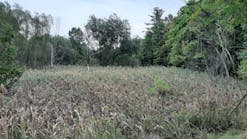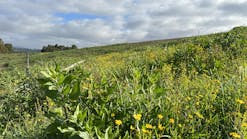Special Permit Requirements for Erosion Control Projects
Meeting permit requirements is just part of the daily routine most erosion control specialists face on their job sites. When the new construction site is part of a nuclear power plant, however, there is nothing routine about following the extensive regulations and requirements that can be challenging.
The V.C. Summer Nuclear Generating Station is a $10 billion power plant project in Jenkinsville, SC. Protective soil stabilization has been carried out at Units 2 and 3 of the site by Mount Pleasant, NC-based Philen Construction since 2009.
Meeting permit requirements is just part of the daily routine most erosion control specialists face on their job sites. When the new construction site is part of a nuclear power plant, however, there is nothing routine about following the extensive regulations and requirements that can be challenging. The V.C. Summer Nuclear Generating Station is a $10 billion power plant project in Jenkinsville, SC. Protective soil stabilization has been carried out at Units 2 and 3 of the site by Mount Pleasant, NC-based Philen Construction since 2009. [text_ad] “Nuclear construction is recognized as special and unique,” explains Karen Kieffer, owner and president of Philen Construction. “V.C. Summer is approximately 1,800 acres of new nuclear construction. The nuclear culture in itself puts it in a category very few will experience. “The challenges are also unique. Work is effectively planned and executed by incorporating job site conditions and the need for coordination with different groups and job activities. There are strict guidelines that must be followed, and revegetation is no exception.” Although the company first considered using blankets for erosion control, Flexterra, a hydraulically applied flexible growth medium from Profile Products, was selected to meet the areas’ specific needs. “Flexterra is ideal for establishing long-term soil and slope protection. It is environmentally friendly, it bonds directly with the soil, and it is immediately effective,” says Kieffer. “Our goal is simple—meet and/or exceed these guidelines. We worked with the engineers to achieve just that. “Nuclear culture and traits are ‘only the best of the best.’ To achieve the ‘best’ we used a combination of hydraulically applied products: Pennington Seed site-specific mix, Uflexx fertilizer, NeutraLime Dry, BioPrime, JumpStart, and Flexterra.” The seed mix used, which includes fescue, Bermuda, bahia, love grass, lespedeza, and annual grasses, is custom blended by Pennington, notes Kieffer. The product is part of the project’s erosion control budget, estimated at $2 million. In addition to working to meet strict rules and regulations at the site, Daryl Philen, EHS/operations manager of Philen Construction, notes, “Maneuvering large equipment safely to achieve desired results due to the varying topography is the most challenging aspect.” Skill in this area is achieved through practice. “Philen Construction is experienced in hydroseeding techniques and the many variables such as safe access to areas, soil conditions, slope length, and appropriate mix of products for optimum stabilization and growth,” says Kieffer. The project is estimated to be complete in 2020. “Philen plans on being onsite when they turn the lights on,” says Kieffer. Commercial Construction Challenges Custom Gardens, based in Amarillo, TX, worked to establish grass at a new truck wash near I-40 in Amarillo, TX, in the fall of 2014. With an erosion control budget of $12,000, the company raced against time to seed the sloped area. [text_ad use_post='27664'] “We used a combination of Bermuda and annual rye, because it was the middle of October and our first freeze is usually the last week of October. I knew the rye would germinate fast, and if the Bermuda would germinate, it might not survive the first freeze. We seeded on a Friday and it was up the following Monday,” says Brooke Furrh, owner of Custom Gardens. “We used some erosion control blanket in the drainage swale where there was a lot of slope and no irrigation.” The hydromulch combination included wood fiber mulch; seed; fertilizers including Ecologel Solutions’ CytoGro, a biostimulant; and Slicky Sticky tackifier, says Furrh. “CytoGro is added to all of our hydromulch to help grass seed establish faster.” Overall, Furrh is pleased with the outcome. “We got the grass up and it is still looking good,” he says. Irrigation also can also prove to be a hydroseeding challenge, as was the case for an acre of slope at Erie Bank on Interchange Road in Erie, PA, in 2013. According to Stephanie Shattuck, vice president of Country Landscape Inc., also based in Erie, the site was located on a hill with no way to irrigate the newly applied seed. Runoff was a concern. “It was approximately 2:1,” she says. “I could hardly stand on it.” The company decided to use Lesco Triplescape seed mix with Lesco Moisture Manager, which draws water molecules into plant roots, in the hydroseeding tank, basing the decision on the success others had using the product. “We planted it with an annual grass to hold the seed in place, for the other seed to germinate,” says Shattuck. The company also used erosion control blankets as part of the erosion control plan, which had a total budget of around $2,500. “It worked out really well,” says Shattuck. “We didn’t have a lot of rain.”“Nuclear construction is recognized as special and unique,” explains Karen Kieffer, owner and president of Philen Construction. “V.C. Summer is approximately 1,800 acres of new nuclear construction. The nuclear culture in itself puts it in a category very few will experience.
“The challenges are also unique. Work is effectively planned and executed by incorporating job site conditions and the need for coordination with different groups and job activities. There are strict guidelines that must be followed, and revegetation is no exception.”
Although the company first considered using blankets for erosion control, Flexterra, a hydraulically applied flexible growth medium from Profile Products, was selected to meet the areas’ specific needs.
“Flexterra is ideal for establishing long-term soil and slope protection. It is environmentally friendly, it bonds directly with the soil, and it is immediately effective,” says Kieffer. “Our goal is simple—meet and/or exceed these guidelines. We worked with the engineers to achieve just that.
“Nuclear culture and traits are ‘only the best of the best.’ To achieve the ‘best’ we used a combination of hydraulically applied products: Pennington Seed site-specific mix, Uflexx fertilizer, NeutraLime Dry, BioPrime, JumpStart, and Flexterra.”
The seed mix used, which includes fescue, Bermuda, bahia, love grass, lespedeza, and annual grasses, is custom blended by Pennington, notes Kieffer. The product is part of the project’s erosion control budget, estimated at $2 million.
In addition to working to meet strict rules and regulations at the site, Daryl Philen, EHS/operations manager of Philen Construction, notes, “Maneuvering large equipment safely to achieve desired results due to the varying topography is the most challenging aspect.”
Skill in this area is achieved through practice. “Philen Construction is experienced in hydroseeding techniques and the many variables such as safe access to areas, soil conditions, slope length, and appropriate mix of products for optimum stabilization and growth,” says Kieffer.
The project is estimated to be complete in 2020. “Philen plans on being onsite when they turn the lights on,” says Kieffer.
Commercial Construction Challenges
Custom Gardens, based in Amarillo, TX, worked to establish grass at a new truck wash near I-40 in Amarillo, TX, in the fall of 2014. With an erosion control budget of $12,000, the company raced against time to seed the sloped area.
“We used a combination of Bermuda and annual rye, because it was the middle of October and our first freeze is usually the last week of October. I knew the rye would germinate fast, and if the Bermuda would germinate, it might not survive the first freeze. We seeded on a Friday and it was up the following Monday,” says Brooke Furrh, owner of Custom Gardens. “We used some erosion control blanket in the drainage swale where there was a lot of slope and no irrigation.”
The hydromulch combination included wood fiber mulch; seed; fertilizers including Ecologel Solutions’ CytoGro, a biostimulant; and Slicky Sticky tackifier, says Furrh. “CytoGro is added to all of our hydromulch to help grass seed establish faster.”
Overall, Furrh is pleased with the outcome. “We got the grass up and it is still looking good,” he says.
Irrigation also can also prove to be a hydroseeding challenge, as was the case for an acre of slope at Erie Bank on Interchange Road in Erie, PA, in 2013. According to Stephanie Shattuck, vice president of Country Landscape Inc., also based in Erie, the site was located on a hill with no way to irrigate the newly applied seed. Runoff was a concern.
“It was approximately 2:1,” she says. “I could hardly stand on it.”
The company decided to use Lesco Triplescape seed mix with Lesco Moisture Manager, which draws water molecules into plant roots, in the hydroseeding tank, basing the decision on the success others had using the product. “We planted it with an annual grass to hold the seed in place, for the other seed to germinate,” says Shattuck. The company also used erosion control blankets as part of the erosion control plan, which had a total budget of around $2,500.
“It worked out really well,” says Shattuck. “We didn’t have a lot of rain.”






